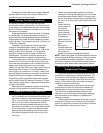
5
Vermont Castings Defiant
Installation
SAFETY NOTICE: IF YOUR DEFIANT IS NOT
PROPERLY INSTALLED, A HOUSE FIRE MAY
RESULT. TO REDUCE THE RISK OF FIRE,
FOLLOW THE INSTALLATION INSTRUCTIONS.
CONTACT LOCAL BUILDING OR FIRE OFFICIALS
ABOUT RESTRICTIONS AND INSTALLATION
INSPECTION REQUIREMENTS IN YOUR AREA.
Before you begin an installation, be sure that:
• Your stove and chimney connector will be far
enough from combustible material to meet all
clearance requirements.
• The floor protector is large enough and is con-
structed properly to meet all requirements.
• You have all necessary permits from local authori-
ties.
Your local building official is the final authority for
approving your installation as safe and determining that
it meets local and state codes.
The metal label permanently attached to the back
of every Vermont Castings' stove indicates that the
stove has been tested to current UL and ULC stan-
dards, and gives the name of the testing laboratory.
Clearance and installation information also is printed on
the label. When the stove is installed according to the
information both on the label and in this manual, local
authorities usually will accept the label as evidence that
the installation meets codes and can be approved.
However, codes vary in different areas. Before
starting the installation, review your plans with the local
building authority. Your local dealer can provide any
additional information needed.
For any unresolved installation issues, refer to the
National Fire Protection Association’s publication
ANSI/
NFPA 211 Standard for Chimneys, Fireplaces, Vents
and Solid Fuel Burning Appliances.
For Canada, the
equivalent publication is
CSA CAN-B365 Installation
Code for Solid Fuel Burning Appliances and Equipment.
These standards are the basis for many national codes.
They are nationally recognized and are accepted by
most local authorities. Your local dealer or your local
building official may have a copy of these regulations.
IMPORTANT: FAILURE TO FOLLOW THESE
INSTALLATION INSTRUCTIONS MAY RESULT IN A
DANGEROUS SITUATION, INCLUDING A CHIMNEY
OR HOUSE FIRE. FOLLOW ALL INSTRUCTIONS
EXACTLY, AND DO NOT ALLOW MAKESHIFT
COMPROMISES TO ENDANGER PROPERTY AND
PERSONAL SAFETY.
Outside Air
In some modern, super-insulated homes, there is
inadequate air supply for combustion because of
insufficient air infiltration into the building. Such air
enters a home through unsealed cracks and openings.
Exhaust fans for kitchen or bath can compete with the
stove for available air and compound the problem.
When poor draft is caused by a low infiltration rate,
opening a ground floor window on the windward side of
the house and near the stove will usually alleviate the
problem.
A better solution is to install a permanent outside air
supply to the stove and/or room. In fact, bringing air for
combustion from outside the home directly to the air inlet
of the stove is required for new construction in some
areas.
Pressure variations within the house do not affect a
stove equipped with an outside air supply, and im-
proved stove performance often results. An Outside Air
Adaptor Kit for the Defiant is available from your local
Vermont Castings dealer.
Chimney Height
Altitude affects chimney performance. When using an
8" oval to 6" flue collar adapter on the Defiant, refer to
Figure 1 for suggested chimney heights at various
altitudes. Chimney height should be measured from the
flue collar to the top of the chimney. The recommended
minimum chimney height is 16 feet (5 meters).
ST491
Fig. 2 Chimney height requirements with 6” chimney and/or
chimney connector.
30
25
20
15
0 2000 4000 6000 8000 10000 12000
Height
Altitude


















